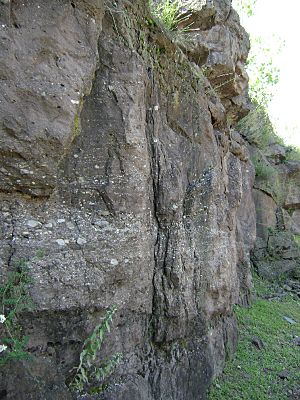Passaic Formation facts for kids
Quick facts for kids Passaic FormationStratigraphic range: Late Triassic, 219–201.7Ma |
|
|---|---|

|
|
| Type | Geological formation |
| Unit of | Newark Supergroup |
| Underlies | Orange Mountain Basalt |
| Overlies | Lockatong Formation |
| Thickness | maximum of over 19,685 feet (6,000 m) |
| Lithology | |
| Primary | Siltstone, Mudstone, Shale |
| Other | Sandstone, Conglomerate |
| Location | |
| Region | Newark Basin of Eastern North America Rift Basins |
| Extent | ~200 miles (320 km) in New York, New Jersey, and Pennsylvania |
| Type section | |
| Named for | Passaic, New Jersey |
| Named by | Paul E. Olsen, 1980 |
The Passaic Formation is a type of rock layer found in Pennsylvania, New Jersey, and New York. It's like a big, old book of Earth's history! This rock layer used to be called the Brunswick Formation. It got its new name from the city of Passaic, New Jersey, close to where scientist Paul E. Olsen first studied it in detail.
Contents
What is the Passaic Formation?
The Passaic Formation is mostly made of reddish-brown rocks. These include shale (a soft, layered rock), siltstone (like hardened mud), and mudstone (similar to siltstone but with finer particles). You can also find some green and brown shale layers mixed in. Near the bottom of the formation, there are red and dark-gray argillites, which are very hard, fine-grained rocks. In New Jersey, you might also see layers of conglomerate (rock made of pebbles) and sandstone (rock made of sand).
How did the Passaic Formation form?
The rocks of the Passaic Formation were laid down in ancient shallow lakes, dry lakebeds (called playas), and areas where rivers spread out (alluvial fans). This happened when the supercontinent Pangea started to break apart. The reddish color of the rocks often tells us that the area was very dry, like a desert, when these sediments were deposited.
The Passaic Formation sits on top of the Lockatong Formation. The Lockatong rocks formed in deeper lakes during wetter times. The materials that made up the Passaic Formation came from the northwest, carrying pieces of older rocks from the Appalachian Mountains.
What fossils are found in the Passaic Formation?
Scientists have found fossils of ancient creatures in the Passaic Formation. One example is:
- Clepsysaurus
How old is the Passaic Formation?
The Passaic Formation formed during the Late Triassic period. This was about 219 to 201.7 million years ago. In some places, this rock layer can be very thick, up to about 13,000 feet (or 4 kilometers)!
The Passaic Formation lies directly above the Lockatong Formation. It is covered by the first layer of volcanic rock, called the Orange Mountain Basalt. The time when the Triassic period ended and the Jurassic period began is found near the very top of the Passaic Formation. This boundary is just a short distance below the Orange Mountain Basalt. You can also find many diabase intrusions (where molten rock pushed into the existing layers) within the Passaic Formation. These intrusions sometimes created metamorphic rocks nearby, which are rocks changed by heat and pressure.

